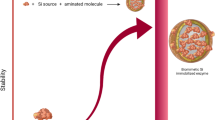Abstract
Effective entrapment of enzymes in solid phase materials is critical to their practical application. The entrapment generally stabilizes biological activity compared to soluble molecules and the material simplifies catalyst integration compared to other methods. A silica sol-gel process based upon biological mechanisms of inorganic material formation (biomineralization) supports protein immobilization reactions within minutes. The material has high protein binding capacity and the catalytic activity of the enzyme is retained. We have demonstrated that both oligopeptides and selected proteins will mediate the biomineralization of silica and allow effective co-encapsulation of other proteins present in the reaction mixture. The detailed methods described here provide a simple and effective approach for molecular biologists, biochemists and bioengineers to create stable, solid phase biocatalysts that may be integrated within sensors, synthetic processes, reactive barriers, energy conversion, and other biotechnology concepts.
Access this chapter
Tax calculation will be finalised at checkout
Purchases are for personal use only
Similar content being viewed by others
References
Gill I, Ballesteros A (1998) Encapsulation of biologicals within silicate, siloxane, and hybrid sol gel polymers: An efficient and generic approach. J Am Chem Soc 120:8587–8598
Mansur H, Orefice R, Vasconcelos W, Lobato Z, Machado L (2005) Biomaterial with chemically engineered surface for protein immobilization. J Mater Sci Mater Med 16:333–340
Dickey FH (1955) Specific adsorption. J Phys Chem 59:695–707
Braun S, Rappoport S, Zusman R, Avnir D, Ottolenghi M (1990) Biochemically active sol-gel glasses: the trapping of enzymes. Mater Lett 10:1–5
Brennan J (2007) Biofriendly sol-gel processing for the entrapment of soluble and membrane-bound proteins:toward novel sold-phase assays for high-throughput screening. Acc Chem Res 40:827–835
Baeuerlein E (2007) Handbook of biomineralization: biological aspects and structure formation, vol 2. Wiley-VCH Verlag GmbH & Co. KGaA, Weinheim
Kröger N, Deutzmann R, Sumper M (1999) Polycationic peptides from diatom biosilica that direct silica nanosphere formation. Science 286:1129–1132
Kröger N, Lorenz S, Brunner E, Sumper M (2002) Self-assembly of highly phosphorylated silaffins and their function in biosilica morphogenesis. Science 298:584–586
Brott LL, Naik RR, Pikas DJ, Kirkpatrick SM, Tomlin DW, Whitlock PW, Clarson SJ, Stone MO (2001) Ultrafast holographic nanopatterning of biocatalytically formed silica. Nature 413:291–293
Luckarift HR, Spain JC, Naik RR, Stone MO (2004) Enzyme immobilization in a biomimetic silica support. Nat Biotechnol 22:211
Naik RR, Tomczak MM, Luckarift HR, Spain JC, Stone MO (2004) Entrapment of enzymes and nanoparticles using biomimetically synthesized silica. Chem Commun. 1684–1685
Cardoso MB, Luckarift HR, Urban VS, O’Neil H, Johnson GR (2010) Protein localization in silica nanosphere derived via biomimetic mineralization. Adv Funct Mater. 3031–3038
Betancor L, Luckarift HR (2008) Bioinspired enzyme encapsulation for biocatalysis. Trends Biotechnol 26:566–572
Sigma-Aldrich. Personal communication
Kroger N, Deutzmann R, Sumper M (2001) Silica-precipitating peptides from diatoms. The chemical structure of silaffin-A from Cylindrotheca fusiformis. J Biol Chem 276:26066–26070
Luckarift HR, Dickerson MB, Sandhage KH, Spain JC (2006) Rapid, room-temperature synthesis of antibacterial bionanocomposites of lysozyme with amorphous silica or titania. Small 2:640–643
Ivnitski D, Artyushkova K, Rincon RA, Atanassov P, Luckarift HR, Johnson GR (2008) Entrapment of enzymes and carbon nanotubes in biologically synthesized silica: glucose oxidase-catalyzed direct electron transfer. Small 4:357–364
Naik RR, Brott LL, Clarson SJ, Stone MO (2002) Silica-precipitating peptides isolated from a combinatorial phage display peptide library. J Nanosci Nanotechnol 2:95–100
Eby DM, Farrington KE, Johnson GR (2008) Synthesis of bioinorganic antimicrobial peptide nanoparticles with potential therapeutic properties. Biomacromolecules 9:2487–2494
Acknowledgements
The research related to the presented methods was supported by the Air Force Research Laboratory Materials Science Directorate, the Air Force Office of Scientific Research (Program Managers, Walt Kozumbo and Jennifer Gresham), and the Joint Science and Technology Office-Defense Threat Reduction Agency (Program Managers, Jennifer Becker and Stephen Lee).
Author information
Authors and Affiliations
Corresponding author
Editor information
Editors and Affiliations
Rights and permissions
Copyright information
© 2017 Springer Science+Business Media New York
About this protocol
Cite this protocol
Johnson, G.R., Luckarift, H.R. (2017). Enzyme Stabilization via Bio-Templated Silicification Reactions. In: Minteer, S. (eds) Enzyme Stabilization and Immobilization. Methods in Molecular Biology, vol 1504. Humana Press, New York, NY. https://doi.org/10.1007/978-1-4939-6499-4_6
Download citation
DOI: https://doi.org/10.1007/978-1-4939-6499-4_6
Published:
Publisher Name: Humana Press, New York, NY
Print ISBN: 978-1-4939-6497-0
Online ISBN: 978-1-4939-6499-4
eBook Packages: Springer Protocols




